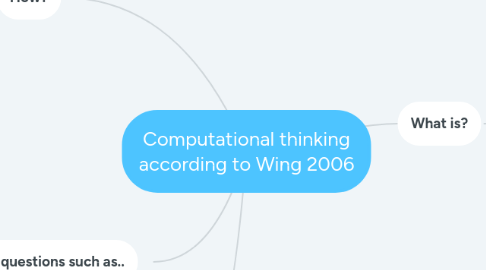Computational thinking according to Wing 2006
by Stine Ejsing-Duun


1. Rises big questions such as..
1.1. What is computable?
1.2. What do computers do better than people?
1.3. What do people do better than people?
2. Is for all
2.1. Why?
2.1.1. It is ubiquitous
2.1.2. Needed within all disciplines
3. How?
3.1. Drawing on concepts from computer science
3.1.1. Randomization
3.1.2. False negatives or positives
3.1.3. Recursion
3.1.4. Parallel processing
3.2. No computer is needed to think in this way or to learn it
3.3. Understand the computer
3.3.1. Constraints
3.3.2. Instruction set = Language
3.4. Reformulate problems
3.4.1. Reduction
3.4.2. Embedding
3.4.3. Transformation
3.4.4. Simulation
4. What is?
4.1. Computational thinking is using abstraction and decomposition when attacking a large complex task or designing a large complex system
4.2. thinking like a computer scientist
4.3. Solving problems
4.3.1. How difficult is it?
4.3.2. What is the best way to solve it?
4.4. Designing systems
4.5. Understanding human behavior
4.6. Code = data; Data = code
4.7. Seperating of concerns
4.8. appropriate representation for a problem or modeling the relevant aspects of a problem to make it tractable.
4.9. Characteristics
4.9.1. Conceptualizing, not programming.
4.9.2. Fundamental, not rote skill
4.9.3. A way that humans, not computers, think.
4.9.4. Complements and combines mathematical and engineering thinking.
4.9.5. Ideas, not artifacts
4.9.6. For everyone, everywhere

